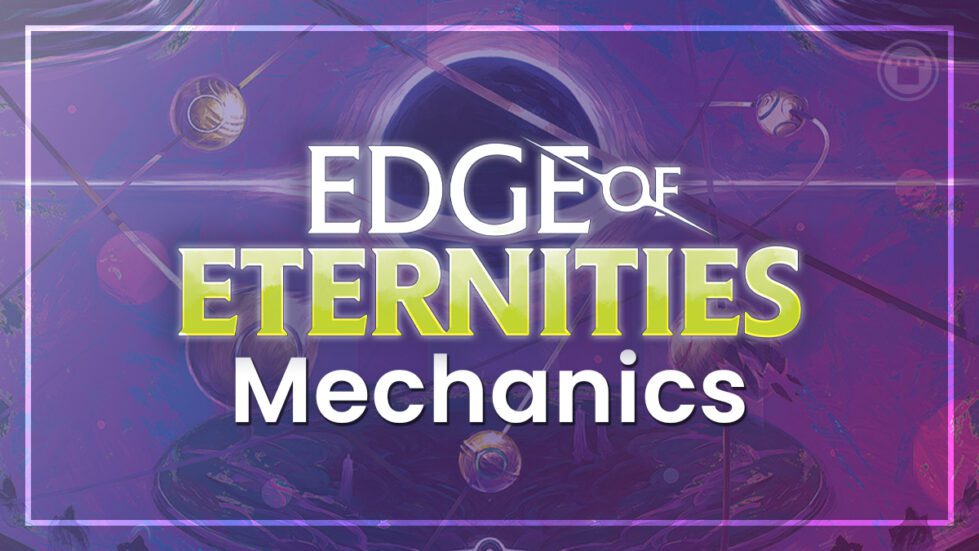Magic is diverting power to its main thrusters, and preparing to boldly go into a new frontier of genre fiction… space opera!
While we’ve had glimpses of advanced tech like robots and rocket launchers since 1994’s Antiquities, and Unfinity added some explicitly interstellar aesthetics to the game, Edge of Eternities is the first time we’ll be exploring the design space that sci-fi can offer.
THE EDGE OF KNOWN SPACE
Even before we look at set mechanics, most planar settings in Magic have an overarching design identity that all the mechanics aligned with that plane tie into.
Theros sets have “enchantments and growing creatures”. Mirrodin sets have “artifacts, especially equipment” and later “phyrexians”. Ixalan sets have “dinosaurs, pirates, vampires and merfolk, plus treasure tokens”. So what defines this new world (or worlds) in EoE?
The Eldrazi have been the most expected component since the first details of the set were known. The lore has been telling us these flying spaghetti monsters originate from the Blind Eternities since their debut, so they should obviously have a big presence in EoE.
Artifact themes are another given – Magic doesn’t necessarily need artifact cards to represent technology, but I think players expect that pairing. Not only will there obviously be a lot of technology involved in a space-exploration story, but there will also be a lot of chance to contrast the technology with untouched natural environments; a contrast that artifact cards can perfectly highlight.
Landfall (and other land-related mechanics) will be the counterpoint to represent the “nature” part of that dichotomy. Wizards have confirmed they want to use weird and wonderful land cards to sell the alien worlds space travellers may stumble across.
One nice thing is that by choosing lands as the nature theme, there’s more natural opportunity for these themes to intermingle within Limited and Constructed decks. Even hardcore artifact decks still have slots for lands – and if the Eldrazi are expensive as usual, having a bunch of land-ramping effects in the same deck is actively beneficial!
I also can’t help but notice that lands, artifacts and eldrazi are the three main categories of colorless card, giving the set another great unifying through-line.
I’LL SHOW YOU “BATTLE-CRUISER MAGIC”
Our first actual new mechanic for Edge of Eternities strengthens those connections between featured card types, as it appears on both artifacts and lands. “Station” is a really elegant and interesting twist on crewing vehicles: instead of tapping your creatures to temporarily turn a car into a creature, you are sending them to help permanently turn on a spaceship, space station or planetary outpost.
I’m a devoted fan of mechanics involving tapping creatures, and I think it’s an excellent idea to re-use the familiar, evocative template of crew for similar concepts: first for saddling mounts in Outlaws of Thunder Junction, and now this. But don’t be fooled into thinking that these cards are going to play just like other vehicles! Station cards are meant to feel a lot “bigger” than vehicles and mounts, compared to the bodies crewing them.
Many are going to have statlines that dwarf normal creatures. One designer was quoted as saying “we wanted 15/15s”. Plus there’d be nothing special about the new cards if you could consistently meet the station requirements in one turn. For fun and balance reasons, I assume most of these must need a significant investment to bring online.
EoE is already going to have the Eldrazi as the payoff for going a “big mana” playstyle, so I really like the decision to have another kind of huge threat which you pay for with a completely different resource. The Brothers’ War set an example of how to convey this kind of bigger-scale combat across a whole set; having ways to “sneak in” more large creatures is a must.
Station is also a lot more open with its rules language than crew or saddle. Not every station card has to turn into a creature as the payoff, and using charge counters to track progress opens up its own set of potential interactions.
All of this means that Wizards can use station costs to help balance out the otherwise very troublesome impact of powerful non-basic lands. Being able to attach a non-mana cost to something nutty like Gaea’s Cradle allows it to still function like a fair land in the early game while slowing down access to the more game-winning abilities.
Not all the changes from crew to station are positives. The combination of sorcery speed activation and needing to activate station separately for each creature lending power can create some highly punishable situations. You could get 90% of the way through tapping guys to bring The Seriema online, and then have an opponent kill your last untapped creature in response to your second-last activation! But at least the progress you make on stationing is cumulative and permanent, so even this blowout is only really exploitable until you untap.
ACCELERATING TO WARP SPEED, CAPTAIN
Just as station builds on the established and successful ideas of crew, the new “Warp” ability evokes past mechanics such as dash, blitz, and… well, evoke. Many creature cards frontload their value through high-impact ETB triggers or hasty attacks. So adding an alternate cast mode where that first turn is all you get creates significant gameplay decisions!
If evoke is the least “generous” version of this mechanic – forcing you to immediately sacrifice the creature at the same time its ETBs are resolving – then Warp is among the most generous. Your warping creature sticks around for a whole turn (until the end step), then goes to exile – but the “on an adventure” part of the exile zone where you can freely re-cast it later for a 2nd burst of value!

The warping creature won’t automatically gain haste, but it can attack if it gets haste from another source or just has haste naturally. It also means that a flash creature could warp in on an opponent’s turn and block! You could even sacrifice it before the end step for some extra value, although it seems as though dying early will cost the warped creature its chance to be re-cast from exile.
We should note here that warp is written as an alternate casting cost, not an ability. So you will be able to warp creatures at instant speed while controlling Vedalken Orrery, pay less mana to warp with Goreclaw, use convoke to pay warp costs with Wand of the Worldsoul, and so on. That also means warping creatures will set off cast triggers (great for those like Gwenna or Rashmi which look at stats or mana value), and be vulnerable to counterspells.

I do like that warp is only usable from your hand; being able to repeatedly “loop” the warp mode feels like it would either end up being useless or boringly overpowered. But that nice, simple implementation of a one-use clause does mean these cards have anti-synergy with red’s impulse-draw and other effects which let you cast from non-hand zones. At least you can still use cascade, discover and similar free-cast effects to play the creature normally!
INTO THE VOID
“Void” is simply a thematic name for a trigger condition that will be appearing across many cards in the set. I’d compare it to morbid, or revolt from Aether Revolt.
Like revolt, void abilities come online whenever at least one permanent has left the battlefield during the current turn. While no cards with void abilities have been spoiled at time of writing, it seems likely that (also like revolt) the linked abilities will either be static, or have specific trigger times (like an ETB trigger or “at the beginning of combat”) to prevent them going off any time anyone cracks a treasure token.
Oh yeah – void cares about anybody’s permanents leaving play, not just yours! Also, warping in a creature will immediately turn on void for the turn, even if it hasn’t actually left play yet.
To offset these advantages, lands leaving the battlefield will not turn on void for you the way they did for revolt. But this seems like a positive change anyway, as it gives the designers a bit more range to create powerful payoffs without worrying they will be abused via fetchlands.
You can still turn on void by sacrificing tokens though! Treasure seems most obvious choice in a broader Constructed context, but Edge of Eternities Limited will give us sac fodder in the form of new non-creature tokens – Landers and Munitions.
WHERE SOME SETS HAVE GONE BEFORE
I should make a point of saying here that comparing these new EoE mechanics to older ones is by no means a critique. Nor do I think it invalidates what I wrote in the introduction, that this set would need a very distinctive mechanical identity.
Even if a mechanic has been worded to superficially resemble past cards, the actual play patterns can still end up feeling completely different. Consider how different your decisions feel using saddle compared to crew, or cards with adventures compared to the omens from Tarkir: Dragonstorm.
These mechanics also seem very well considered for the Standard card pool they will be joining. I can’t wait to try stationing with the “survivor” creatures from Duskmourn, or combine the new spacecraft with the existing vehicle themes from Aetherdrift.
A lot still rests on how exactly these abilities are utilized on the actual cards, but my early scans are showing strong signs of life for Edge of Eternities card design.

Tom’s fate was sealed in 7th grade when his friend lent him a pile of commons to play Magic. He quickly picked up Boros and Orzhov decks in Ravnica block and has remained a staunch white magician ever since. A fan of all Constructed formats, he enjoys studying the history of the tournament meta. He specializes in midrange decks, especially Death & Taxes and Martyr Proc. One day, he swears he will win an MCQ with Evershrike. Ask him how at @AWanderingBard, or watch him stream Magic at twitch.tv/TheWanderingBard.









